Uncle Bush's Picture Book
Many photographs that appear elsewhere in this web presentation are included in this page, with additional notes, observations, and research findings. There are a few pictures, gleaned from antique newspapers, that will only appear here. Their quality is generally so poor that they do not well represent their subject.
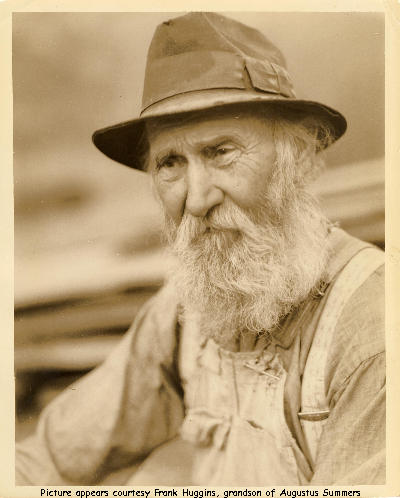 This is Uncle Bush; full name Felix Bushaloo Breazeale, born June 29, 1864. His 'pappy' was Drury Wood Breazeale. I have seen several spellings of the name Drury (Drewry, Drewrey, etc.), so I suppose Drury is as good as any. The consensus seems to have it Drury. Uncle Bush couldn't read or write, and one assumes his 'pappy' couldn't either, so it was left to other people to figure out how to spell the names. Often they were written in a bible by someone who could do so to whatever degree of expertise and whatever they wrote was what the person went with through life.
This is Uncle Bush; full name Felix Bushaloo Breazeale, born June 29, 1864. His 'pappy' was Drury Wood Breazeale. I have seen several spellings of the name Drury (Drewry, Drewrey, etc.), so I suppose Drury is as good as any. The consensus seems to have it Drury. Uncle Bush couldn't read or write, and one assumes his 'pappy' couldn't either, so it was left to other people to figure out how to spell the names. Often they were written in a bible by someone who could do so to whatever degree of expertise and whatever they wrote was what the person went with through life.
Uncle Bush was a simple farmer and somewhat of a private person, in spite of his fame. Some have described him as a hermit and claimed that he lived alone most of his life. He never married, but he didn't live alone. He lived with his parents until they passed, then a sister, then a nephew. He lived in the same area his entire life, and had little, if any, formal education. He raised chickens and hunted the foxes that preyed on them. Numerous hounds were trained during his life to help him hunt the foxes. He wore bib overalls and plowed with a mule. From quasi-evidence I will offer later, he dipped snuff; dry, powdered snuff. He was good with his hands. A crack shot with a rifle, he could apparently drop a fox at a hundred yards. He was a skilled woodworker, a craftsman. As a young man, he had some trouble with the law, but came clear of it, and lived out his life without further run-ins. When he was in his early forties, he joined the church and was reported to be a regular attendee for over thirty years.
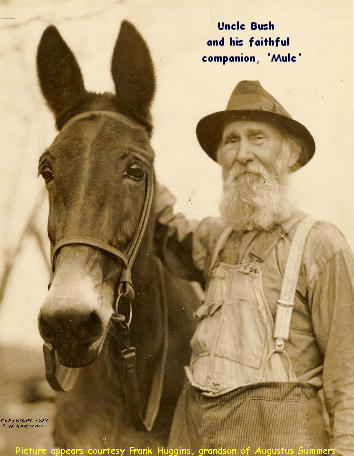 When Uncle Bush was in his mid-fifties, he acquired a mule colt. He called the colt 'Mule', and that became her name. They were constant companions and formed a special bond. He was convinced that she was smarter than many people. He taught her tricks and seemed to be able to communicate with her directly.
When Uncle Bush was in his mid-fifties, he acquired a mule colt. He called the colt 'Mule', and that became her name. They were constant companions and formed a special bond. He was convinced that she was smarter than many people. He taught her tricks and seemed to be able to communicate with her directly.
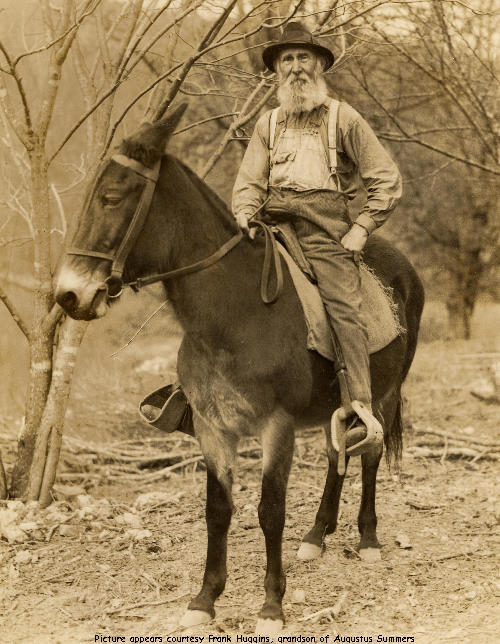 When Uncle Bush needed to go to the store for supplies or to town for any reason, he rode Mule, or Mule pulled his wagon. Mule also pulled his plow, dragged logs, helped uproot stumps, and performed any other task that required her power. Some sources, before as well as after the funeral, have stated that Mule would be/was involved in the funeral procession, pulling the wagon that carried the casket to the church. This, however, was either speculation before the event or made up embellishment afterward. No eyewitness account mentions any involvement by Mule, whatsoever. Uncle Bush's empty casket was carried in a hearse, an automobile. Uncle Bush sat in the front seat, beside the driver. Mule is documented to have been in the barnyard during the funeral.
When Uncle Bush needed to go to the store for supplies or to town for any reason, he rode Mule, or Mule pulled his wagon. Mule also pulled his plow, dragged logs, helped uproot stumps, and performed any other task that required her power. Some sources, before as well as after the funeral, have stated that Mule would be/was involved in the funeral procession, pulling the wagon that carried the casket to the church. This, however, was either speculation before the event or made up embellishment afterward. No eyewitness account mentions any involvement by Mule, whatsoever. Uncle Bush's empty casket was carried in a hearse, an automobile. Uncle Bush sat in the front seat, beside the driver. Mule is documented to have been in the barnyard during the funeral.
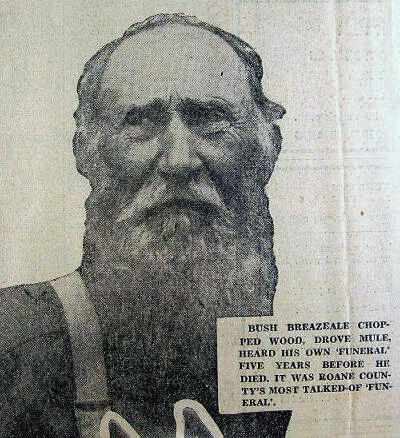 Just after Uncle Bush's twenty-seventh birthday, in the summer of 1891, a neighbor was murdered one evening while rolling his buggy into the barn. A blast from a double barrel shotgun came from the darkness of a corn row near the barn and dropped him in his tracks. He was killed almost instantly. The man helping him saw nothing as he had his back turned, pulling the buggy into the barn. The dead man was Brack Smith, a constable of Roane County, well-known and well-respected throughout the region. The assailant made a clean getaway.
Just after Uncle Bush's twenty-seventh birthday, in the summer of 1891, a neighbor was murdered one evening while rolling his buggy into the barn. A blast from a double barrel shotgun came from the darkness of a corn row near the barn and dropped him in his tracks. He was killed almost instantly. The man helping him saw nothing as he had his back turned, pulling the buggy into the barn. The dead man was Brack Smith, a constable of Roane County, well-known and well-respected throughout the region. The assailant made a clean getaway.
The murder happened sometime after dark on the evening of August 6, 1891. In December of that year, the circuit court of the district indicted Felix Breazeale for the murder and he was arrested on January 3, 1892. Bail was set at $5000, which Bush did not meet, so he remained in the Roane County Jail. Four months later, on April 17, another man, Ephraim Miller, was arrested and charged for the same crime. The case went to trial and subsequently Bush was acquitted. The only comment that I have been able to find from Uncle Bush was that the charges were based on suspicion and circumstantial evidence and he wanted the true facts given at his funeral. Click here for an interesting study of the true facts surrounding the case. As far as we know, the Brack Smith murder was not mentioned at Uncle Bush's funeral.
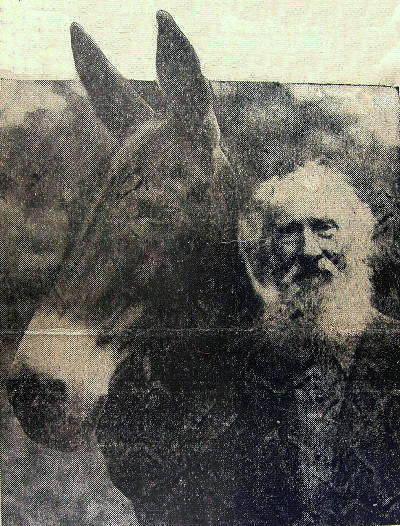 Mule was almost as big a celebrity as Uncle Bush was after the funeral. People would come from miles around and all throughout the day to visit Uncle Bush. Of course, they all wanted to see the fine black walnut coffin he had built with his own hands. He kept the coffin in the barn. It was something to see, having been lined in satin, fitted with strong sculpted lifting handles and polished to a lusterous sheen. Well, the barn was Mule's domain. Everyone had heard about Mule and Uncle Bush's apparent ability to communicate with her and the tricks she could perform, so every trip to the barn with a group of visitors meant that Mule had to run through her repertoire. On the busiest days, weekends mostly, Mule would get tired of 'entertaining' the guests and Uncle Bush would have to beg off for her. Most of the time, though, she was a trooper.
Mule was almost as big a celebrity as Uncle Bush was after the funeral. People would come from miles around and all throughout the day to visit Uncle Bush. Of course, they all wanted to see the fine black walnut coffin he had built with his own hands. He kept the coffin in the barn. It was something to see, having been lined in satin, fitted with strong sculpted lifting handles and polished to a lusterous sheen. Well, the barn was Mule's domain. Everyone had heard about Mule and Uncle Bush's apparent ability to communicate with her and the tricks she could perform, so every trip to the barn with a group of visitors meant that Mule had to run through her repertoire. On the busiest days, weekends mostly, Mule would get tired of 'entertaining' the guests and Uncle Bush would have to beg off for her. Most of the time, though, she was a trooper.
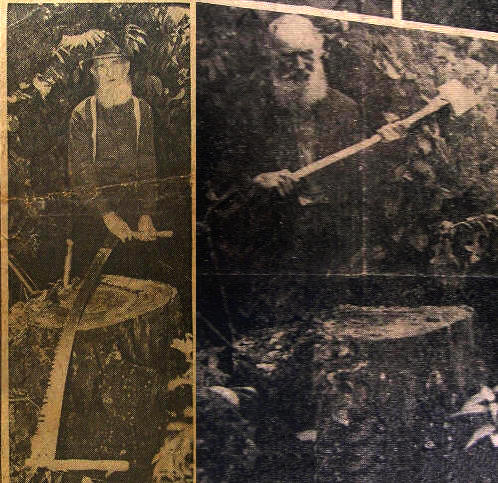 These two pictures show the black walnut stump that remained after the tree was felled in the back of Uncle Bush's cabin, and the tools he used to bring it down. With Mule's help, I'm sure, he took the log to the local sawmill to have the boards cut to his specifications. Then, the wood was cured to insure that it would not split or warp. Only then did he begin the long and arduous task of transforming the roughhewn lumber into his casket.
These two pictures show the black walnut stump that remained after the tree was felled in the back of Uncle Bush's cabin, and the tools he used to bring it down. With Mule's help, I'm sure, he took the log to the local sawmill to have the boards cut to his specifications. Then, the wood was cured to insure that it would not split or warp. Only then did he begin the long and arduous task of transforming the roughhewn lumber into his casket.
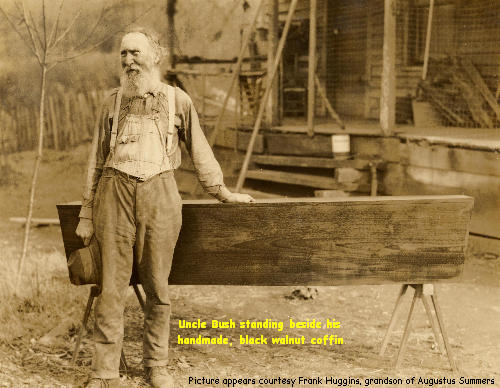 The construction process of the casket continued throughout the winter of 1937 and 1938. This picture was taken in front of his cabin in the spring, just before he hauled the completed box to Berry's Funeral Home in Knoxville, where it was 'dressed' with a white satin lining and shiny metal fittings. Hand polishing brought out the woods natural patina. The casket was ready in the late spring of 1938. It was a work of art, a craftsmans masterpiece, perfect for it's intended purpose.
The construction process of the casket continued throughout the winter of 1937 and 1938. This picture was taken in front of his cabin in the spring, just before he hauled the completed box to Berry's Funeral Home in Knoxville, where it was 'dressed' with a white satin lining and shiny metal fittings. Hand polishing brought out the woods natural patina. The casket was ready in the late spring of 1938. It was a work of art, a craftsmans masterpiece, perfect for it's intended purpose.
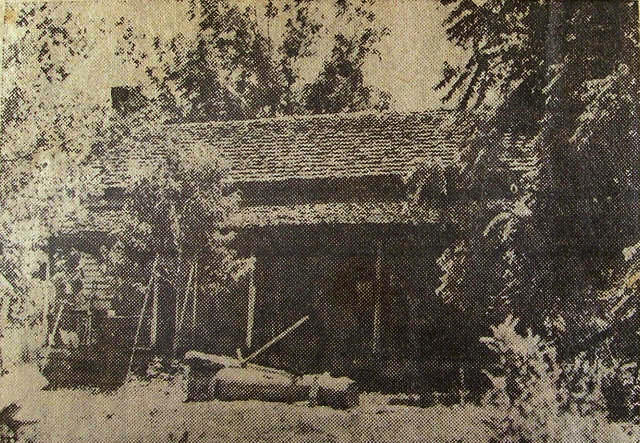 This is the simple cabin in which Uncle Bush was living at the time of the funeral. It is unclear if he lived in this same cabin all his life. It is known that he lived with his parents until they passed, then one reference tells that his sister 'kept house for him' until she passed, and finally he lived with a nephew, Bert Breazeale. There was no running water or electricity or central heat, unless you consider a fireplace in the center of one wall as 'central heat', or, perhaps, a woodburning stove in the middle of the room. Cooking was probably done on a wood burning stove. He cut all his own firewood. Bathroom facilities were most likely an 'outhouse', located down a short trail in back of the cabin.
This is the simple cabin in which Uncle Bush was living at the time of the funeral. It is unclear if he lived in this same cabin all his life. It is known that he lived with his parents until they passed, then one reference tells that his sister 'kept house for him' until she passed, and finally he lived with a nephew, Bert Breazeale. There was no running water or electricity or central heat, unless you consider a fireplace in the center of one wall as 'central heat', or, perhaps, a woodburning stove in the middle of the room. Cooking was probably done on a wood burning stove. He cut all his own firewood. Bathroom facilities were most likely an 'outhouse', located down a short trail in back of the cabin.
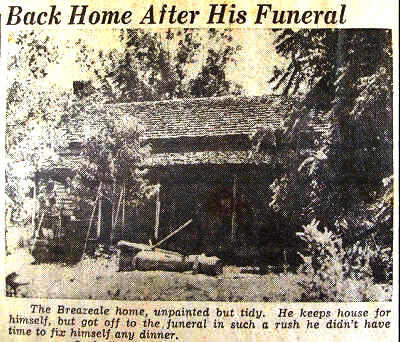 The picture above appeared in the Knoxville News-Sentinel on Monday, June 27, 1938, the day after the funeral. The article that accompanied it was the most comprehensive and included more comments and quotes from Uncle Bush and his friends than any yet uncovered. However, the article posted on the main page of this presentation was taken from the Roane County Banner, a fine article in it's own right, in honor of Augustus Summers, the editor, who publicized the event and brought it all to fruition. Click here to read the text of the News-Sentinel piece written by Bonnie Tom Robinson.
The picture above appeared in the Knoxville News-Sentinel on Monday, June 27, 1938, the day after the funeral. The article that accompanied it was the most comprehensive and included more comments and quotes from Uncle Bush and his friends than any yet uncovered. However, the article posted on the main page of this presentation was taken from the Roane County Banner, a fine article in it's own right, in honor of Augustus Summers, the editor, who publicized the event and brought it all to fruition. Click here to read the text of the News-Sentinel piece written by Bonnie Tom Robinson.
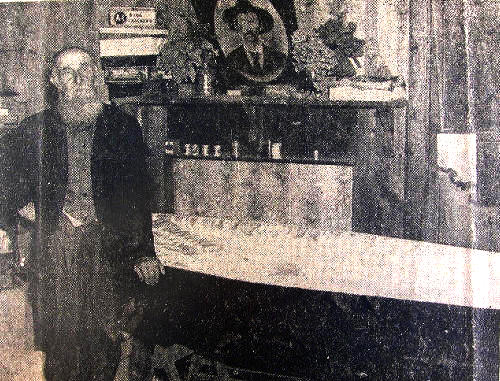 This photograph was printed in The Harriman Record of October 24, 1957. It accompanied an article written by Betty Magee. This is the only picture I have seen showing the inside of Uncle Bush's three-room home. He is standing beside his fully appointed casket, which is sitting on sawhorses in the 'living room' of the cabin. He does not appear to be dressed for the funeral, so this picture was probably taken during a photo-op visit after the funeral. He seems to be wearing the same clothes in the pictures above with the axe in hand and standing beside Mule, so several pictures were made on that day. In the background, the mantlepiece does not appear to be framing a fireplace. The 'wallpaper' is continuous above and below the mantle. The picture on the mantle is thought to be Uncle Bush's 'pappy', Drury Wood Breazeale. Lined up on the left side of the shelf below the mantle are what look like tins of powdered snuff, perhaps Tube Rose, or Butterscotch, or Garrett.
This photograph was printed in The Harriman Record of October 24, 1957. It accompanied an article written by Betty Magee. This is the only picture I have seen showing the inside of Uncle Bush's three-room home. He is standing beside his fully appointed casket, which is sitting on sawhorses in the 'living room' of the cabin. He does not appear to be dressed for the funeral, so this picture was probably taken during a photo-op visit after the funeral. He seems to be wearing the same clothes in the pictures above with the axe in hand and standing beside Mule, so several pictures were made on that day. In the background, the mantlepiece does not appear to be framing a fireplace. The 'wallpaper' is continuous above and below the mantle. The picture on the mantle is thought to be Uncle Bush's 'pappy', Drury Wood Breazeale. Lined up on the left side of the shelf below the mantle are what look like tins of powdered snuff, perhaps Tube Rose, or Butterscotch, or Garrett.
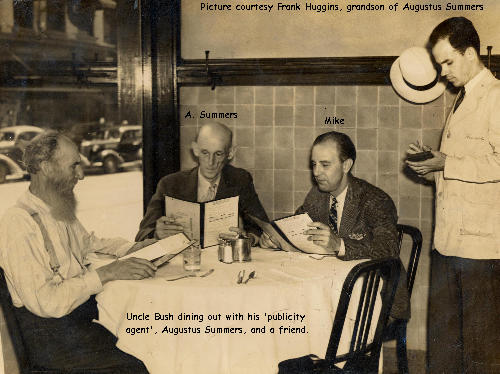 Here we see Uncle Bush in a cafe, ordering a meal. The man to his left is Augustus Summers, editor of The Roane County Banner and Uncle Bush's agent. This is the only picture I have seen of Mr. Summers. The other man is a friend named Mike. That is all we know. By magnifying the picture we can see that the cafe is named Weavers. It is not known where or when the picture was taken, but we can speculate. We know that Uncle Bush traveled to Knoxville, both before and after the funeral, and to New York City for his spot on the Ripley's Believe It Or Not program. Mr. Huggins reports that, to the best of his knowledge, his grandfather did not travel with Uncle Bush to NYC, so our best guess is that the picture was made on the trip to Knoxville, during the week before the funeral, to fit Uncle Bush with his new suit at Hall's Men's Clothing of Knoxville. That is pure speculation, based on comparison of certain aspects of this photograph with the next photograph, taken in Hall's during the fitting. We also know that Uncle Bush traveled to Knoxville for an interview on WNOX Radio. The cafe picture could be from that trip, but the picture of Uncle Bush speaking into the microphone, that you can see below, does not compare as well as the Hall's picture. As a matter of fact, all three of the pictures could have been made on the same trip. He appears to be wearing the same shirt in all three pictures, but he may have donned his 'best' shirt for out-of-town trips. I wonder what Uncle Bush ordered that day and how he came to the decision, considering that he could not read the menu.
Here we see Uncle Bush in a cafe, ordering a meal. The man to his left is Augustus Summers, editor of The Roane County Banner and Uncle Bush's agent. This is the only picture I have seen of Mr. Summers. The other man is a friend named Mike. That is all we know. By magnifying the picture we can see that the cafe is named Weavers. It is not known where or when the picture was taken, but we can speculate. We know that Uncle Bush traveled to Knoxville, both before and after the funeral, and to New York City for his spot on the Ripley's Believe It Or Not program. Mr. Huggins reports that, to the best of his knowledge, his grandfather did not travel with Uncle Bush to NYC, so our best guess is that the picture was made on the trip to Knoxville, during the week before the funeral, to fit Uncle Bush with his new suit at Hall's Men's Clothing of Knoxville. That is pure speculation, based on comparison of certain aspects of this photograph with the next photograph, taken in Hall's during the fitting. We also know that Uncle Bush traveled to Knoxville for an interview on WNOX Radio. The cafe picture could be from that trip, but the picture of Uncle Bush speaking into the microphone, that you can see below, does not compare as well as the Hall's picture. As a matter of fact, all three of the pictures could have been made on the same trip. He appears to be wearing the same shirt in all three pictures, but he may have donned his 'best' shirt for out-of-town trips. I wonder what Uncle Bush ordered that day and how he came to the decision, considering that he could not read the menu.
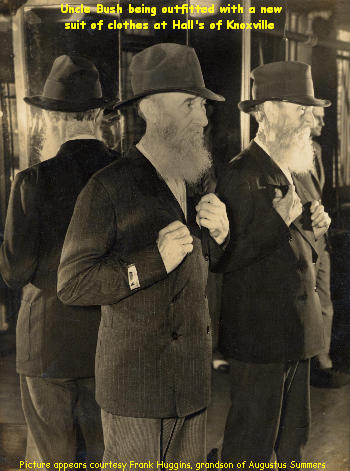 Uncle Bush in Hall's of Knoxville, the men's clothing store that provided the new suit he wore to the funeral. This picture was taken during the fitting and appears to be the double-breasted pinstripe suit that he chose. He is wearing a pair of corderoy trousers in the picture, which is different from the type of pants he was wearing in the cafe picture above. The fabric of the corderoy trousers looks new and pressed, so he may have been trying them on, perhaps considering a different suit.
Uncle Bush in Hall's of Knoxville, the men's clothing store that provided the new suit he wore to the funeral. This picture was taken during the fitting and appears to be the double-breasted pinstripe suit that he chose. He is wearing a pair of corderoy trousers in the picture, which is different from the type of pants he was wearing in the cafe picture above. The fabric of the corderoy trousers looks new and pressed, so he may have been trying them on, perhaps considering a different suit.
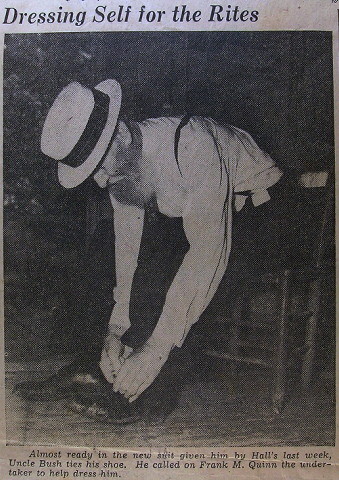 On the front porch of his cabin on the day of the funeral, Uncle Bush is almost ready to go. One has to wonder if he put his hat on before anything else. He chose undertaker Frank Quinn to help him dress, commenting that Mr. Quinn had dressed a lot of dead men, and he just hoped Mr. Quinn was up to dressing a live one.
On the front porch of his cabin on the day of the funeral, Uncle Bush is almost ready to go. One has to wonder if he put his hat on before anything else. He chose undertaker Frank Quinn to help him dress, commenting that Mr. Quinn had dressed a lot of dead men, and he just hoped Mr. Quinn was up to dressing a live one.
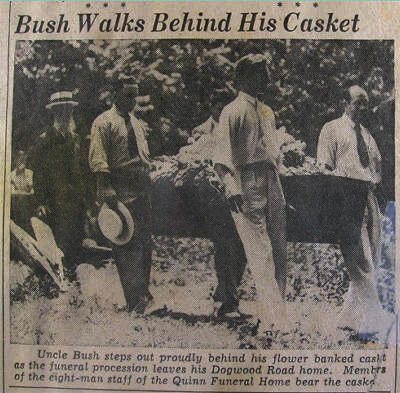 The funeral procession began at Uncle Bush's cabin, where the casket was located. Here the staff of Quinn's Funeral Home, not Uncle Bush's pallbearers, are carrying the casket to the hearse for the ride to the Cave Creek Baptist Church. Uncle Bush strolls along behind. The much anticipated big day has finally begun.
The funeral procession began at Uncle Bush's cabin, where the casket was located. Here the staff of Quinn's Funeral Home, not Uncle Bush's pallbearers, are carrying the casket to the hearse for the ride to the Cave Creek Baptist Church. Uncle Bush strolls along behind. The much anticipated big day has finally begun.
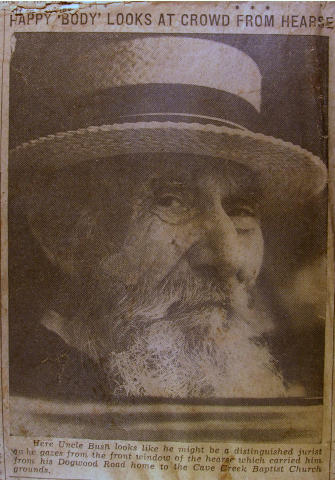 Uncle Bush rode in the front passenger seat of the hearse and chatted with the driver during the short ride to the church. The ride took 40 minutes due to the clogged traffic jam that had developed since the huge crowd began to accumulate. Here, Uncle Bush is looking out the passenger window of the hearse, directly into the camera. It looks like he's got his game face on. Once they were in sight of the church, Mr. Quinn directed the pallbearers to abandon the hearse, take up the coffin, and carry it the final distance to the tent that had been set up outside. The police had difficulty making a path through the crowd, while Uncle Bush walked solemnly behind, through the excited onlookers and in the festive atmosphere they had created.
Uncle Bush rode in the front passenger seat of the hearse and chatted with the driver during the short ride to the church. The ride took 40 minutes due to the clogged traffic jam that had developed since the huge crowd began to accumulate. Here, Uncle Bush is looking out the passenger window of the hearse, directly into the camera. It looks like he's got his game face on. Once they were in sight of the church, Mr. Quinn directed the pallbearers to abandon the hearse, take up the coffin, and carry it the final distance to the tent that had been set up outside. The police had difficulty making a path through the crowd, while Uncle Bush walked solemnly behind, through the excited onlookers and in the festive atmosphere they had created.
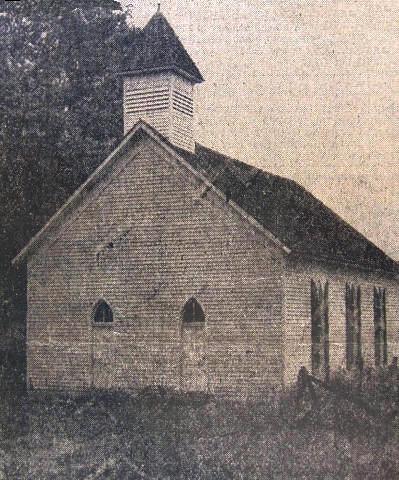 This picture appeared in The Harriman Record in October, 1957. It was there to represent the Cave Creek Baptist Church, the destination of the Bush funeral train, but our research indicates that it is not the same church that was on the grounds of the Cave Creek Primitive Baptist Church in June of 1938. If you study the picture below, it is a panoramic view of the Church grounds and clearly shows the crowd, the tent, and the Church building. The architecture of the building above does not in any way match the architecture of the building below, except that they are both rectangular in shape, have three windows on a side, and a cupola that represents a steeple. Beyond those general similarities, they are nothing alike. Until we have new information that tells us the church was rebuilt some time before 1957, we think The Harriman Record published the wrong picture. It is obviously a church, but which church? If we find out that it is a new building in 1957, then that makes us wonder how many buildings the church has had since it's foundation in 1829? Today, 2007, it has a completely different building.
This picture appeared in The Harriman Record in October, 1957. It was there to represent the Cave Creek Baptist Church, the destination of the Bush funeral train, but our research indicates that it is not the same church that was on the grounds of the Cave Creek Primitive Baptist Church in June of 1938. If you study the picture below, it is a panoramic view of the Church grounds and clearly shows the crowd, the tent, and the Church building. The architecture of the building above does not in any way match the architecture of the building below, except that they are both rectangular in shape, have three windows on a side, and a cupola that represents a steeple. Beyond those general similarities, they are nothing alike. Until we have new information that tells us the church was rebuilt some time before 1957, we think The Harriman Record published the wrong picture. It is obviously a church, but which church? If we find out that it is a new building in 1957, then that makes us wonder how many buildings the church has had since it's foundation in 1829? Today, 2007, it has a completely different building.
This information had been posted here for almost three years when I got the following letter from Ava Harvey of Knoxville, Tennessee.
xxxxxxxxxxxxxxxxxxxxxxxxxxxxxxxxxxxxxxxxxxxxxxxxxxxxxxxxxxxxxxxxxxxxx
Sent: Wednesday, July 21, 2010 7:14 PM
Subject: Regarding Cave Creek Baptist Church
Dear Mick,
I have spent quite a long period of time reading your website. What a great compilation of history! This story has been a tale I have heard from my family since my childhood in the 60s. It was nice to get a straight story of the events as there has always been a bit of mystery surrounding it all. Thank you for such a great historical account.
My dad (born in 1930), along with his family, were long-time members of the Cave Creek community and of the Cave Creek Baptist church. And according to what I've been told, the Harvey family was instrumental in the founding and building of the church. So, I was hoping to clear up a small matter you write about regarding the conflict of church buildings photographed during the event.
You see, I was raised and subsequently saved in Cave Creek MISSIONARY Baptist Church. This is the church that was photographed with 2 doors in front (the newspaper got it right). This church is the original structure and would have been accurate to the time period of the funeral. The building became in disrepair and the members opted to burn it down in the late '90s ....rebuilding on the hillside just above the cemetary (the new structure). As for the other church you see in the photograph with all the masses, that building is the original structure of the Cave Creek PRIMITIVE Baptist Church. Both buildings were located in the "bottom flat" and just a few feet from each other. If memory serves me, the original MISSIONARY church suffered a split early on and the other congregation began meeting in the structure you see that is the PRIMITIVE Church. I believe Uncle Breazeale was a member of the MISSIONARY Church, but clearly, the throngs of attendees would spill into the same view of the PRIMITIVE building. (Sam McNabb was a pallbearer for Bush and he was a very strong proponent and member of the MISSIONARY church, I remember Sam very well.)
My dad's family farm was located immediately behind Sam McNabb's farm and both farms are now owned by my dad (Avery Harvey). These farms are located just about a 1/4 mile down from the church "bottom." Story has it that the "barn" was burned after the constable was shot and that the barn was located immediately behind the MISSIONARY Church (with the 2 doors).
Perhaps, by now, none of this is news to you. Clearly, you have researched your uncle extensively and done an outstanding job. It was not apparent that you live in close proximety to Cave Creek, so I just wanted to offer what little I know to the cause.
I'm going to talk with my dad more about all this...will make a trip down there soon and have him point out just where Uncle Bush lived. I'm pointing my dad to your website tonight, as he will looove reading your collection.
In closing, my dad's family were strong community members (Harvey's and Hall's), but my grandmother on my mom's side was a McNabb and I remember well her telling of attending the funeral. She kept the newspaper clippings and I remember seeing them as a child and her telling the story. So, your account has been a wonderful reflection of a childhood legend.
Many thanks and sincerely,
Ava Harvey
Knoxville, Tennessee
Part of my reply to her letter:
Hello Ava,
Glad to get back to answering your letter. I was intrigued with your discription of the orientation of the two churches on the bottom flat. From what I gather from your letter, the 1957 Harriman Record picture of the church with two doors is the actual Missionary Baptist Church that was standing at the time of the Bush funeral, just a few 'feet' from the Primitive Church. Not only that, but you are also saying that the 'church with two doors' was the actual destination of the funeral procession before it was moved outside to the tent set up under the huge sycamore tree immediately next to the Primitive Church. Could the picture of the gathering crowd have been taken from the roof of the Missionary Church?
xxxxxxxxxxxxxxxxxxxxxxxxxxxxxxxxxxxxxxxxxxxxxxxxxxxxxxxxxxxxxxxxxxxxxxxx
So, based on this new information from Ava, the church building published in 1957 by the Harriman Record, is the original Missionary Baptist Church, before it was rebuilt on the hill above the cemetary. It is likely that the picture below, of the crowd gathering around the tent near the Primitive Baptist Church, was taken from the roof of the Missionary Baptist Church. Thank you Ava for clearing it up.
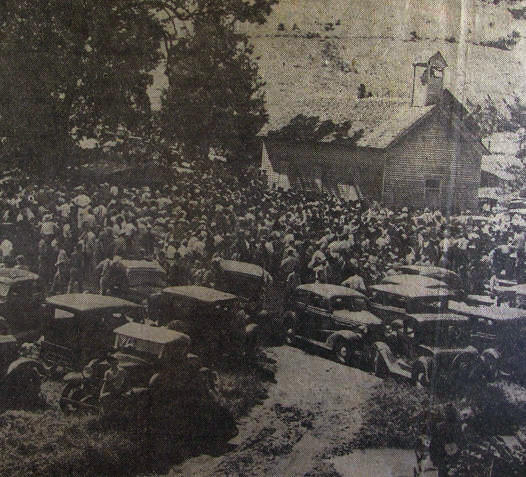 This picture was published in the Knoxville News-Sentinel the day after the funeral. It accompanied an article by Bonnie Tom Robinson. The crowd is still gathering and is substantially smaller than the crowd shown in the picture below, published in the Roane County Banner, which was taken at the same distance but from a slightly different vantage point. The distinguishing feature of the picture above is the number of automobiles shown in the church 'parking lot'. Many of these vehicles had been removed to make room for the crowd by the time the Banner picture was made. At least they are not visible in the dense crowd. The caption that appeared under the picture above was, "This is just one segment of the crowd, estimated at from five to fifteen thousand people, who turned out for the Breazeale funeral. Thirty years ago Uncle Bush joined the Cave Creek Baptist Church. Yesterday he drew the biggest crowd it ever had." That statement contains both the lowest and the highest estimates of the crowd size found in our research.
This picture was published in the Knoxville News-Sentinel the day after the funeral. It accompanied an article by Bonnie Tom Robinson. The crowd is still gathering and is substantially smaller than the crowd shown in the picture below, published in the Roane County Banner, which was taken at the same distance but from a slightly different vantage point. The distinguishing feature of the picture above is the number of automobiles shown in the church 'parking lot'. Many of these vehicles had been removed to make room for the crowd by the time the Banner picture was made. At least they are not visible in the dense crowd. The caption that appeared under the picture above was, "This is just one segment of the crowd, estimated at from five to fifteen thousand people, who turned out for the Breazeale funeral. Thirty years ago Uncle Bush joined the Cave Creek Baptist Church. Yesterday he drew the biggest crowd it ever had." That statement contains both the lowest and the highest estimates of the crowd size found in our research.
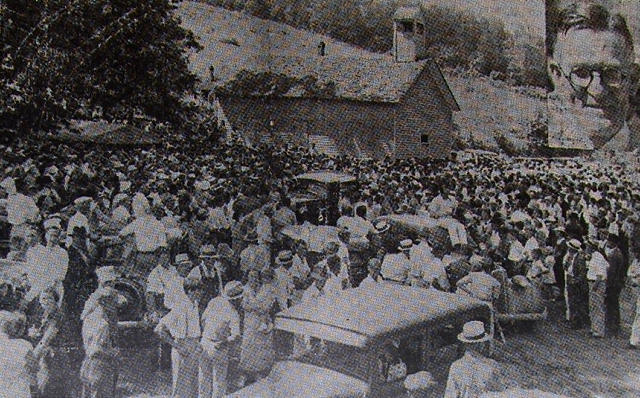 This was the lead photograph published in the Roane County Banner on Thursday, June 30, 1938, four days after the funeral and the day after Uncle Bush's 74th birthday. The Banner was a weekly paper that came out on Thursday. In the upper right hand corner is an inset photo of Rev. Charles E. Jackson, Uncle Bush's favorite preacher, who had traveled over 500 miles to preside over the funeral service. The tent canopy, which sheltered the casket, Uncle Bush, and the other participants in the service, is seen in the upper left corner. It was set up hastily on the morning of the funeral when it became plain that the church would not hold the gathering crowd.
This was the lead photograph published in the Roane County Banner on Thursday, June 30, 1938, four days after the funeral and the day after Uncle Bush's 74th birthday. The Banner was a weekly paper that came out on Thursday. In the upper right hand corner is an inset photo of Rev. Charles E. Jackson, Uncle Bush's favorite preacher, who had traveled over 500 miles to preside over the funeral service. The tent canopy, which sheltered the casket, Uncle Bush, and the other participants in the service, is seen in the upper left corner. It was set up hastily on the morning of the funeral when it became plain that the church would not hold the gathering crowd.
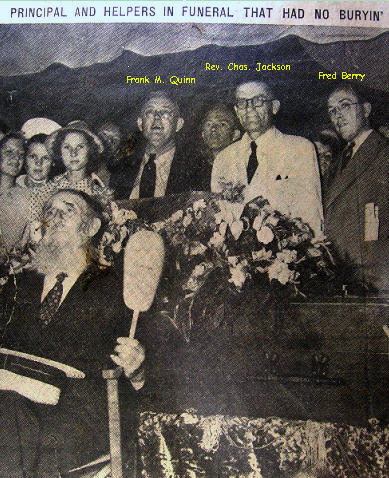 Here Uncle Bush is finally in place and ready for the service to begin. The picture was printed in the Knoxville News-Sentinel, the day after the funeral. Under the picture, the following caption appeared: "The big moment of Uncle Bush's life. Seated in front of the casket which he helped make from a walnut tree. He is waiting for the Rev. Charles E. Jackson of Paris, Ill. to start his funeral services. Behind Bush stands Frank M. Quinn of the Quinn Funeral Home of Loudon, who had charge of the services as undertaker. At Quinn's left is the Rev. Charles E. Jackson and at Jackson's left is Fred Berry of the Berry Funeral Home of Knoxville, who sang 'There's A Gold Mine In The Sky'". The young women and others in the picture were probably members of The Friendly Eight Octette, The Kingston Quartette, or the Knoxville Quartette, who sang the remaining seven songs listed in the program. Uncle Bush is holding one of 1500 fans provided by Quinn's Funeral Home. That number may represent the best estimate of the crowd size projected by the event planners, or it may simply be all the fans Mr. Quinn had on hand at the time.
Here Uncle Bush is finally in place and ready for the service to begin. The picture was printed in the Knoxville News-Sentinel, the day after the funeral. Under the picture, the following caption appeared: "The big moment of Uncle Bush's life. Seated in front of the casket which he helped make from a walnut tree. He is waiting for the Rev. Charles E. Jackson of Paris, Ill. to start his funeral services. Behind Bush stands Frank M. Quinn of the Quinn Funeral Home of Loudon, who had charge of the services as undertaker. At Quinn's left is the Rev. Charles E. Jackson and at Jackson's left is Fred Berry of the Berry Funeral Home of Knoxville, who sang 'There's A Gold Mine In The Sky'". The young women and others in the picture were probably members of The Friendly Eight Octette, The Kingston Quartette, or the Knoxville Quartette, who sang the remaining seven songs listed in the program. Uncle Bush is holding one of 1500 fans provided by Quinn's Funeral Home. That number may represent the best estimate of the crowd size projected by the event planners, or it may simply be all the fans Mr. Quinn had on hand at the time.
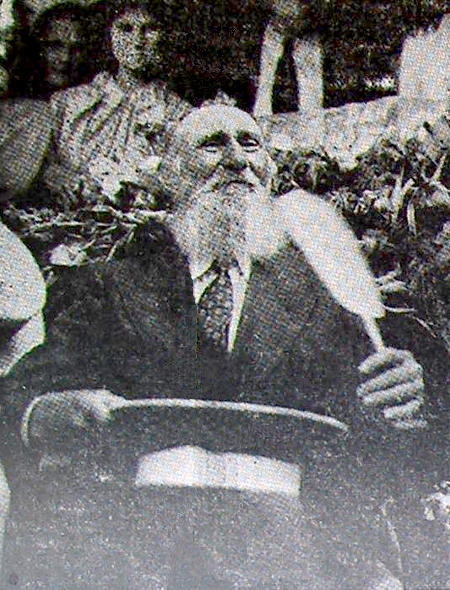 Uncle Bush enjoyed the day perhaps more than anyone there. He reportedly commented that the sermon was the finest he had ever heard and he was pleased with all the "doin's and goin's on". "This will be my only funeral," he declared, "and I'm mighty well pleased with it. When I die there won't be another one." The magnitude of the event did concern him, however. He'd had in mind to have a quiet affair, he said, until the newspapers got "aholt of it" and let everybody know about it. There were visitors from as far away as the states of Washington and New York. License plates from fourteen states were noted.
Uncle Bush enjoyed the day perhaps more than anyone there. He reportedly commented that the sermon was the finest he had ever heard and he was pleased with all the "doin's and goin's on". "This will be my only funeral," he declared, "and I'm mighty well pleased with it. When I die there won't be another one." The magnitude of the event did concern him, however. He'd had in mind to have a quiet affair, he said, until the newspapers got "aholt of it" and let everybody know about it. There were visitors from as far away as the states of Washington and New York. License plates from fourteen states were noted.
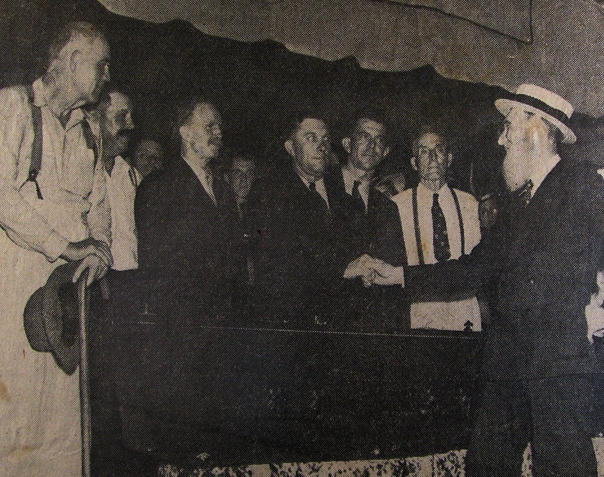 As soon as the service was completed, Uncle Bush rose to thank his pallbearers. This photograph, printed in the Knoxville News-Sentinel, was underscored with: "Four of the pallbearers, all fox-hunting pals of Mr. Breazeale, got crowded out and were unable to reach the funeral tent until after the service. Uncle Bush is shaking hands with Horace Brooks of Lenoir City. The others are Ebb Huff, Ed McDaniel, Sam McNabb, J. W. Grubb and Ed McNabb". It was approaching the evening hours before Uncle Bush was able to leave the church grounds. Thousands of the attendees pressed in to shake his hand and wish him well. Many pinched a flower or two, from sprays on top of the casket, to keep as mementos of the day. Four large sprays were picked clean of flowers, leaves, stems and all.
As soon as the service was completed, Uncle Bush rose to thank his pallbearers. This photograph, printed in the Knoxville News-Sentinel, was underscored with: "Four of the pallbearers, all fox-hunting pals of Mr. Breazeale, got crowded out and were unable to reach the funeral tent until after the service. Uncle Bush is shaking hands with Horace Brooks of Lenoir City. The others are Ebb Huff, Ed McDaniel, Sam McNabb, J. W. Grubb and Ed McNabb". It was approaching the evening hours before Uncle Bush was able to leave the church grounds. Thousands of the attendees pressed in to shake his hand and wish him well. Many pinched a flower or two, from sprays on top of the casket, to keep as mementos of the day. Four large sprays were picked clean of flowers, leaves, stems and all.
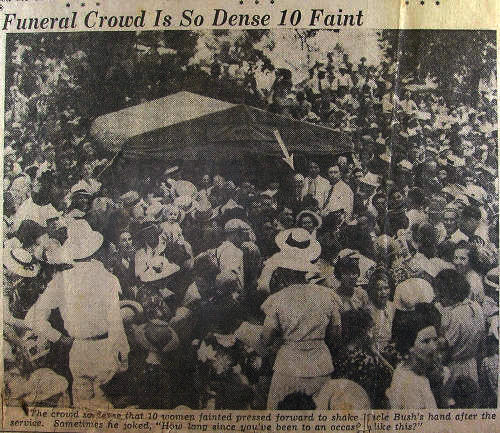 The day was hot and humid, the crowd was very thick, so thick in fact, that women began to faint and one man had a stroke. Uncle Bush stayed to receive all who wanted to speak to him. Men shook his hand, women patted his back, mothers made their babies reach out and touch him. It went on for hours. (The caption of the photograph above says: The crowd, so dense that 10 women fainted, pressed forward to shake Uncle Bush's hand after the service. Sometimes he joked, "How long since you've been to an occasion like this?") Many wanted to also see the black walnut casket up close. One was J. L. Cook, the owner of the sawmill that had cut the big tree into boards the previous fall. "I just wanted to see what it looked like," he said, as he admired Uncle Bush's fine craftsmanship.
The day was hot and humid, the crowd was very thick, so thick in fact, that women began to faint and one man had a stroke. Uncle Bush stayed to receive all who wanted to speak to him. Men shook his hand, women patted his back, mothers made their babies reach out and touch him. It went on for hours. (The caption of the photograph above says: The crowd, so dense that 10 women fainted, pressed forward to shake Uncle Bush's hand after the service. Sometimes he joked, "How long since you've been to an occasion like this?") Many wanted to also see the black walnut casket up close. One was J. L. Cook, the owner of the sawmill that had cut the big tree into boards the previous fall. "I just wanted to see what it looked like," he said, as he admired Uncle Bush's fine craftsmanship.
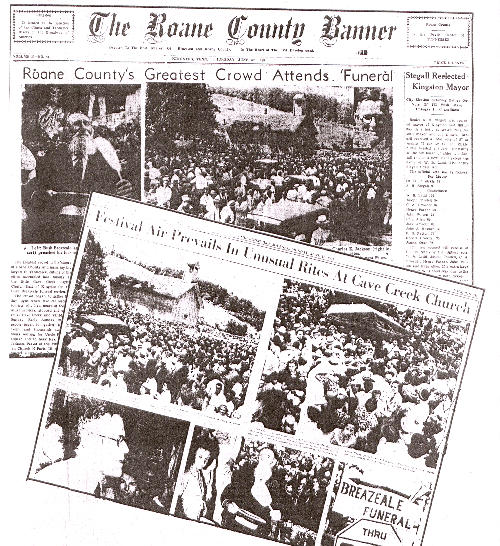 The front page and second page of the Roane County Banner was full of pictures along with the eyewitness report posted on the opening page of this display. The funeral was big news for every newspaper for miles around. The size of the crowd had taken the planners by complete surprise, and, of course, that was a tribute to the vision Augustus Summers had had, inspired so many months before with the answer to a simple question in a friendly conversation, "What is your plan for that black walnut tree?" The event was six or seven months in the planning, came to pass in a few hours, generated miles of printed lines, years of memories, and is still talked about in Roane County, Tenn.
The front page and second page of the Roane County Banner was full of pictures along with the eyewitness report posted on the opening page of this display. The funeral was big news for every newspaper for miles around. The size of the crowd had taken the planners by complete surprise, and, of course, that was a tribute to the vision Augustus Summers had had, inspired so many months before with the answer to a simple question in a friendly conversation, "What is your plan for that black walnut tree?" The event was six or seven months in the planning, came to pass in a few hours, generated miles of printed lines, years of memories, and is still talked about in Roane County, Tenn.
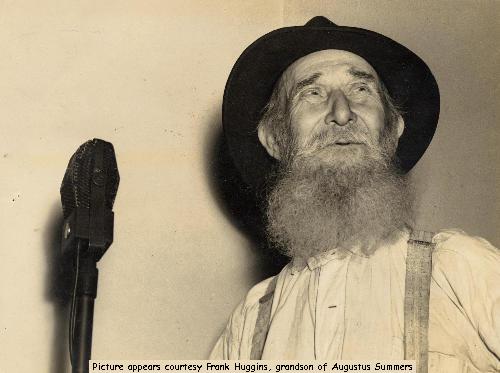 Uncle Bush was genuine celebrity for quite some time after the funeral, beginning on July 4, 1938 when he was dressed in a baseball uniform and threw out the first pitch of a local baseball game. He was interviewed in print and on radio. The photo above is believed to be from a radio interview he gave on WNOX of Knoxville. He traveled to New York City to be interviewed live on Robert Ripley's nationally syndicated radio program, Ripley's Believe It Or Not. Life Magazine reportedly featured him and his casket in one of their weekly publications. He received fan mail from around the world, and had visitors virtually every day up until the time of his death in 1943. Charlie Breazeale, accompanied by Lula, daughters Jewell and Clara, oldest son Everette and his wife, Grace, made the 900 mile round-trip journey to visit Uncle Bush about 1940. They were entertained by him, walked down to the barn to see the casket, and met Mule, who performed a few tricks for them.
Uncle Bush was genuine celebrity for quite some time after the funeral, beginning on July 4, 1938 when he was dressed in a baseball uniform and threw out the first pitch of a local baseball game. He was interviewed in print and on radio. The photo above is believed to be from a radio interview he gave on WNOX of Knoxville. He traveled to New York City to be interviewed live on Robert Ripley's nationally syndicated radio program, Ripley's Believe It Or Not. Life Magazine reportedly featured him and his casket in one of their weekly publications. He received fan mail from around the world, and had visitors virtually every day up until the time of his death in 1943. Charlie Breazeale, accompanied by Lula, daughters Jewell and Clara, oldest son Everette and his wife, Grace, made the 900 mile round-trip journey to visit Uncle Bush about 1940. They were entertained by him, walked down to the barn to see the casket, and met Mule, who performed a few tricks for them.
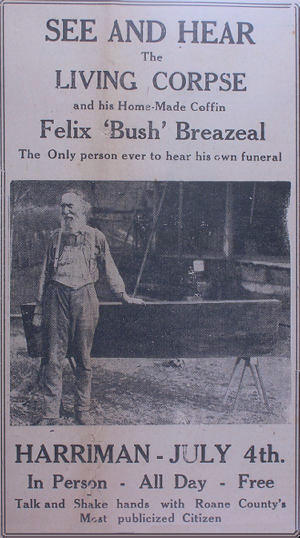 This poster provided advertisement for the Fourth of July festivities in Harriman, Tenn., one of which was the baseball game between Harriman and Loudon that featured Uncle Bush in uniform tossing the first pitch. As you can see, Uncle Bush was considered the main attraction of the day, in person, all day, free! Uncle Bush must have had amazing stamina for a 74 year old man, to have been able to endure these events without fatiguing.
This poster provided advertisement for the Fourth of July festivities in Harriman, Tenn., one of which was the baseball game between Harriman and Loudon that featured Uncle Bush in uniform tossing the first pitch. As you can see, Uncle Bush was considered the main attraction of the day, in person, all day, free! Uncle Bush must have had amazing stamina for a 74 year old man, to have been able to endure these events without fatiguing.
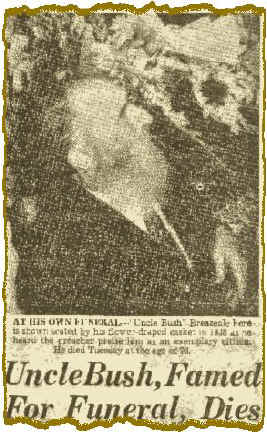 Uncle Bush died quietly at home, about 7:30 in the evening, on Feb. 9, 1943, four years, seven months and thirteen days after his famous funeral. This picture appeared in the Knoxville Journal on Feb. 10, with a short article that reviewed the remarkable event that was his claim to fame. The caption reads: "AT HIS OWN FUNERAL - 'Uncle Bush' Breazeale here is shown seated by his flower-draped casket in 1938 as he heard the preacher praise him as an exemplary citizen. He died Tuesday at the age of 78."
Uncle Bush died quietly at home, about 7:30 in the evening, on Feb. 9, 1943, four years, seven months and thirteen days after his famous funeral. This picture appeared in the Knoxville Journal on Feb. 10, with a short article that reviewed the remarkable event that was his claim to fame. The caption reads: "AT HIS OWN FUNERAL - 'Uncle Bush' Breazeale here is shown seated by his flower-draped casket in 1938 as he heard the preacher praise him as an exemplary citizen. He died Tuesday at the age of 78."
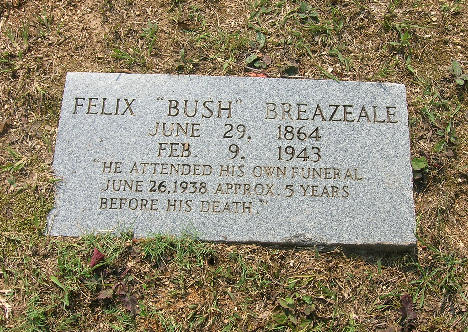 Uncle Bush left specific instructions for the burial procedure he wanted performed after his death. He was to lie in state for one hour at the cemetery, there was to be no funeral, and he was to be buried in the famous black walnut casket that he had built for the purpose. It would be interesting to know if he was buried in the double-breasted pinstripe suit, topped off by the sporty, straw Italian Boater.
Uncle Bush left specific instructions for the burial procedure he wanted performed after his death. He was to lie in state for one hour at the cemetery, there was to be no funeral, and he was to be buried in the famous black walnut casket that he had built for the purpose. It would be interesting to know if he was buried in the double-breasted pinstripe suit, topped off by the sporty, straw Italian Boater.
He was buried on Sunday, Feb. 13, 1943, in an unmarked grave in the Cave Creek Cemetery. Quinn's Funeral Home was in charge of the interment, as they had been in charge of the funeral. They followed Uncle Bush's instructions. There was no eulogy, no songs, and only a few people attended the final ritual, a simple committal service. The weather was very cold and the crowd was small, in stark contrast to the festive atmosphere of that sweltering day in June, 1938, four-and-a-half years earlier.
Above is the headstone for Uncle Bush's grave, located in the Cave Creek Cemetery of Roane County, Tenn. Originally, and for most of the time since he was buried, his grave was unmarked. In 1986, this simple stone was added by a concerned citizens group.
Page 1 of
1
Home|Back
|




























